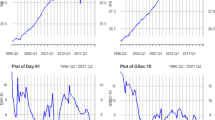Abstract
This paper deals with the demand for money, including narrow money (M 1) and broad money (M 2) in China. We use the cointegration and error‐correction model to formulate the function of money demand and merge the short‐run and long‐run equations to give forecasts over different horizons. In particular, we combine very simple artificial neural networks (ANNs) with the cointegration and error‐correction model to give a nonlinear model. These models are quarterly models, sampled from the first quarter of 1980 to the fourth quater of 1994, and the multi‐step forecasts are from the first quarter of 1990 to the fourth quarter of1994. Both the fitted values and predictive values for M 1 and M 2 are satisfactory. Finally, we give forecasts for M 2 from the first quarter of 1995 to the second quarter of 1996.
Similar content being viewed by others
References
W.J. Baume, The transaction demand for cash: An inventory theoretic approach, Quarterly Journal of Economics 66(1952)545-556.
J. Tobin, The interest elasticity of transactions demand for cash, Review of Economics and Statistics 38(1956)241-247.
D.E.W. Laidler, The Demand for Money: Theories, Evidence, and Problems, 3rd ed., New York, 1985.
Qin Wanshun and Guo Shibang, Money demand model and analysis in our country, Financial Research 10(1991)11-18 (in Chinese).
Shen Kunrong, The quantative analysis of money demand in our country, Predicting 2(1993)60-62 (in Chinese).
Wang Cheng and Zheng Shaolian, The econometric study of the demand for currency, Journal of Fudan University 4(1988)1-12 (in Chinese).
Yi Gang, The estimation of money demand in China, Chinese Social Sciences Quarterly 8(Summer 1994)15-30 (in Chinese).
C.R. Nelson and Plosser, Trends and random walks in macroeconomic time series: Some evidence and implications, Journal of Monetary Economics 10(1982)139-162.
C.W.J. Granger and P. Newbold, Forecasting Economic Time Series, Academic Press, 1986.
D.A. Dickey and W.A. Fuller, Distribution of the estimation for autoregressive time series with a unit root, Journal of the American Statistical Association 74(1979)427-431.
W.A. Fuller, Introduction to Statistical Time Series, Wiley, New York, 1976.
W.R. Easterly, P. Mauro and K. Schmidt-Hebbel, Money demand and Seigniorag-maximization inflation, Journal of Money, Credit and Banking 27(1995)583-603.
K. Cuthbertson, S.G. Hall and M.P. Taylor, Applied Econometric Techniques, Philip Allan, New York, 1992.
S.G. Hall, Applied Economic Forecasting Techniques, Harvester Wheatsheaf, New York, 1994.
R. Davidson and J.G. Mackinnon, Estimation and Inference in Econometrics, Oxford University Press, London, 1994.
R.F. Engle and C.W.J. Granger, Co-integration and error-correction: Representation, estimation and testing, Econometrica 55(1987)251-276.
D.F. Hendry and N. Ericsson, An econometric analysis of UK money demand in monetary trens in the United States and the United Kingdom by Milton Friedman and Anna J. Schwartz, The American Economic Review 81(1991)8-38.
R.W. Hafer and D.W. Jansen, The demand for money in the United States: Evidence from co-integration tests, Journal of Money, Credit and Banking 23(1991)155-168.
R.F. Engle and B.S. Yoo, Forecasting and testing in co-integrated systems, Journal of Econometrics 35(1987)145-159.
C.L. Gilbert, Professor Hendry's econometric methodology, Oxford Bulletin of Economics and Statistics 48(1986)283-307.
A. Escribano, Cointegration, time co-trends and error-correction systems: An alternative approach, CORE Discussion Paper No. 8715, 1987.
A. Ichocki and R. Unbehauen, Neural Networks for Optimization and Signal Processing, Wiley, New York, 1993.
J. Hertz, A. Krogh and R.G. Palmer, Introduction to the Theory of Neural Computation, Addison-Wesley, New York, 1991.
Rights and permissions
About this article
Cite this article
Deng, S., Liu, B. Modelling and forecasting the money demand in China: Cointegration and non‐linearanalysis. Annals of Operations Research 87, 177–189 (1999). https://doi.org/10.1023/A:1018972717158
Issue Date:
DOI: https://doi.org/10.1023/A:1018972717158




